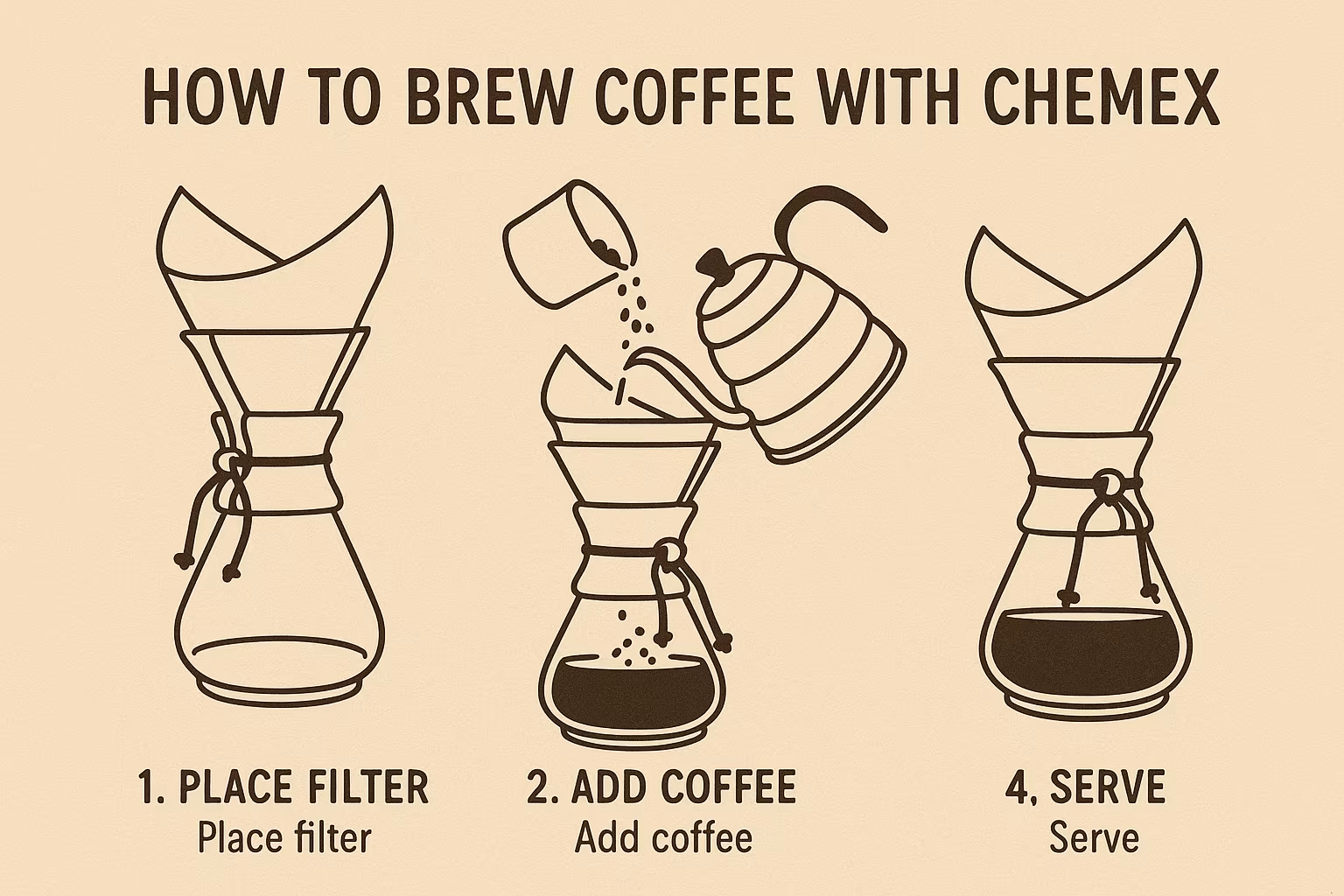Learn how to brew coffee with Chemex in this step-by-step guide. Explore equipment, grind size, coffee-to-water ratios, common mistakes, and expert tips to make rich, clean coffee at home like a barista.
How to Brew Coffee with Chemex: A Complete Guide 2025
Few coffee brewing methods are as iconic as the Chemex, a timeless glass brewer designed in 1941 by Dr. Peter Schlumbohm. Known for its elegant hourglass design and ability to produce an exceptionally clean, flavorful cup, the Chemex has earned its place both in museum exhibits and in the daily rituals of coffee lovers worldwide.
If you are looking for a clear, practical, and barista-approved method for how to brew coffee with Chemex, this guide will walk you step by step through the process while sharing expert insights, common mistakes to avoid, and tips for mastering your brew.
Step-by-Step Guide: How to Brew Coffee with Chemex
The Chemex brewing method is all about precision, patience, and practice. When done correctly, it highlights the coffee’s delicate aromas, producing a bright, nuanced cup free from sediment or bitterness. Here is a detailed, structured process to help you achieve consistency.
Essential Equipment and Ingredients
Before you start, make sure you have:
A Chemex brewer (3-cup, 6-cup, 8-cup, or 10-cup)
Chemex bonded paper filters or reusable metal filters
Freshly roasted coffee beans (preferably single-origin)
A burr grinder (for consistent grind size)
Kettle with gooseneck spout for controlled pouring
Digital scale for accurate measurements
Hot water at 195–205°F (90–96°C)
Tip: Specialty Coffee Association (SCA) research shows that using precise equipment dramatically improves consistency, ensuring the same great flavor every time.
Step 1: Heat Water and Prepare the Filter
Start by heating your water to the optimal brewing range (195–205°F). Place the Chemex filter into the brewer with the triple-folded side aligned along the spout. Rinse the filter thoroughly with hot water—this removes any papery taste and preheats the vessel. Discard the rinse water before adding coffee grounds.
Step 2: Measure Coffee-to-Water Ratio
The golden rule is 1:15 to 1:17 ratio of coffee to water, depending on taste preference. For example:
30 grams of coffee → 450–510 grams of water
40 grams of coffee → 600–680 grams of water
Using a digital scale ensures precision. Many professional baristas recommend starting with a 1:16 ratio and adjusting based on desired strength.
Step 3: Grind Size for Perfect Extraction
Grind size is critical. The ideal grind for Chemex is medium-coarse, resembling sea salt. Too fine, and your brew will be over-extracted and bitter. Too coarse, and it will taste weak and under-extracted. According to James Hoffmann, world coffee expert, “Grind size is one of the most powerful variables in brewing; even small adjustments can transform your cup.”
Step 4: Blooming Phase
Add ground coffee into the filter, then pour twice the weight of water as your coffee dose (e.g., 30 g coffee → 60 g water) in a circular motion. This is called the bloom. Allow it to sit for 30–45 seconds. This step releases trapped carbon dioxide, ensuring even extraction. You will see bubbles rise—a sign your coffee is fresh.
Step 5: Pouring Technique for Balance
After blooming, pour water slowly in concentric circles, keeping the water level consistent without flooding. Aim for a steady pour, allowing the water to draw down naturally. Continue adding water in stages until you reach your target weight. Total brew time should be around 3.5–5 minutes, depending on grind size and volume.
Step 6: Finishing and Serving
Once the water has passed through, remove the filter and discard grounds. Swirl the Chemex lightly to mix the brew, then pour into a preheated cup. The result should be a clean, balanced cup with clarity of flavor and no sediment. Unlike French press or moka pot, Chemex emphasizes brightness and subtlety—perfect for showcasing single-origin coffees.
Brewing Tips for Better Chemex Coffee
Even after following the standard steps, small tweaks can elevate your brew. Here are expert recommendations.
Adjusting Water Temperature
Water that is too hot (>205°F) can over-extract, creating bitterness, while cooler water (<195°F) under-extracts, producing flat flavors. Stick within the recommended range but don’t be afraid to experiment for different bean profiles.
Choosing Fresh, Quality Beans
The Chemex shines when paired with light to medium roasts and high-quality single-origin beans. Ethiopia Yirgacheffe, Colombia Supremo, and Kenya AA are excellent choices. Freshness matters—use beans roasted within the last 2–3 weeks.
See more: Cold Brew vs Iced Coffee: Key Differences Explained
Experimenting with Different Ratios
While 1:16 is a good baseline, some beans respond better to 1:15 (stronger, fuller body) or 1:17 (cleaner, lighter taste). Keeping a brewing journal helps track your adjustments.
Proverb: “The best time to drink coffee was 20 minutes ago. The second best time is now.” With Chemex, you can make every cup feel like the right time.
Common Mistakes When Brewing with Chemex
Even seasoned coffee lovers can make errors that affect flavor. Avoid these pitfalls for consistent success.
Using the Wrong Grind Size
A grind too fine slows extraction, producing bitterness, while too coarse leaves you with a watery brew. Always calibrate your grinder to achieve a medium-coarse consistency.
Skipping the Filter Rinse
Neglecting to rinse the filter can impart an unpleasant papery taste to your brew. It also prevents proper preheating of the Chemex, which can drop brewing temperature.
Over- or Under-Steeping
If your brew finishes in under 3 minutes, it may taste weak; if it exceeds 6 minutes, it risks bitterness. Adjust grind size and pouring pace to maintain balance.
Chemex vs Other Brewing Methods
To truly appreciate the elegance of the Chemex, it helps to compare it with other popular brewing methods. Each has strengths, but the Chemex offers a unique combination of design and clarity.
Chemex vs French Press
The French Press produces a heavier, fuller-bodied cup by allowing oils and fine sediment to pass through its metal mesh filter. The Chemex, by contrast, uses thick bonded paper filters that remove nearly all oils and particles, yielding a cleaner, brighter flavor profile. If French Press is like a hearty stew, Chemex is like a delicate consommé—both nourishing, but in different ways.
Chemex vs V60 Pour Over
The Hario V60 and Chemex are both pour-over methods, but they differ in filter design and flow rate. The V60 uses thinner filters and a single large opening, which allows for faster flow and more control over extraction variables. The Chemex, with its thicker filters, slows down the process and emphasizes clarity. As many baristas observe, the V60 tends to highlight acidity, while the Chemex highlights sweetness and balance.
Chemex vs Automatic Drip Coffee
Automatic drip machines prioritize convenience, but they often lack the precision of manual pour-over. Brewing with Chemex gives you complete control over grind size, pouring technique, and water temperature, resulting in a more refined and intentional cup. For those who see coffee as a ritual rather than a routine, Chemex stands out.
How to Care for Your Chemex Brewer
Proper care ensures that your Chemex lasts for years and continues to produce delicious coffee. Neglecting maintenance can lead to residue buildup, affecting flavor and hygiene.
Cleaning After Each Brew
After each brew, rinse your Chemex with warm water and mild soap. Avoid abrasive sponges that may scratch the glass. A quick rinse prevents coffee oils from clinging to the surface, which can impart rancid flavors over time.
Deep Cleaning for Longevity
Once a week, perform a deep clean. Add a mixture of baking soda and warm water or use specialized coffee equipment cleaners. Swirl gently and rinse thoroughly. Some Chemex models are dishwasher safe, but hand washing is often preferred to preserve clarity.
Storing and Maintaining Filters
If you use paper filters, store them in a dry, odor-free environment. For cloth filters, rinse immediately after brewing and keep them submerged in water inside a sealed container in the fridge to avoid mold. Metal filters should be rinsed and scrubbed after each use to prevent clogging.
Proverb: “Cleanliness is next to godliness.” In coffee brewing, it’s also the difference between a cup that delights and one that disappoints.
Conclusion: Mastering How to Brew Coffee with Chemex
Learning how to brew coffee with Chemex is not just about technique—it’s about embracing a ritual that merges design, science, and art. The Chemex stands out because it encourages mindfulness in brewing while rewarding patience with a cup of exceptional clarity.
Key Takeaways for Perfect Brewing
Use a medium-coarse grind (like sea salt) for ideal extraction.
Stick to a 1:15–1:17 coffee-to-water ratio for balanced strength.
Don’t skip the blooming phase, as it releases gases and enhances flavor.
Rinse the filter before brewing to remove papery taste and stabilize temperature.
Total brew time should fall within 3.5–5 minutes for optimal balance.
Proper care—cleaning, storage, and filter maintenance—extends the life of your Chemex and preserves coffee quality.
Final Thoughts: Elevating Your Coffee Ritual
The Chemex is more than a brewing device—it is a symbol of coffee culture’s commitment to precision and beauty. From its permanent display at the Museum of Modern Art in New York to its daily use by baristas and home enthusiasts, it embodies the fusion of form and function. Brewing with Chemex allows you to slow down, experiment, and savor the nuances of coffee that might otherwise be overlooked.

My name is Kara Chavez, and I love coffee. I love making the best coffees – espresso, latte, macchiato. I always strive for perfection in my barista skills, and I take great pride in bringing delicious cups of coffee to my customers.
I’ve been in the coffee industry for many years, and I know everything there is to know about brewing the perfect cup of coffee. My passion for coffee shines through in every cup I make, and I hope you’ll stop by soon so I can share my love of coffee with you!

